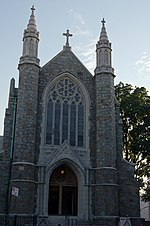Saint Demetrios Astoria School
AC with 0 elementsAstoria, QueensChristian schools in New York (state)Eastern Orthodox schools in the United StatesEastern Orthodoxy in New York (state) ... and 7 more
Greek-American culture in New York CityGreek Orthodoxy in the United StatesNew York City school stubsPrivate elementary schools in Queens, New YorkPrivate high schools in Queens, New YorkPrivate middle schools in Queens, New YorkQueens, New York building and structure stubs
Saint Demetrios Preparatory School is a private Greek Orthodox Christian school located in Astoria, Queens, New York City. It is the largest Greek-American and Greek Orthodox day school in the United States, as well as the only Greek Orthodox high school in the United States. It enrolls students from preschool to twelfth grade. The school is associated with the Saint Demetrios Cathedral.
Excerpt from the Wikipedia article Saint Demetrios Astoria School (License: CC BY-SA 3.0, Authors).Saint Demetrios Astoria School
30th Drive, New York Queens
Geographical coordinates (GPS) Address Nearby Places Show on map
Geographical coordinates (GPS)
| Latitude | Longitude |
|---|---|
| N 40.765833333333 ° | E -73.923055555556 ° |
Address
Saint Demetrios Greek American School
30th Drive 30-03
11102 New York, Queens
New York, United States
Open on Google Maps








